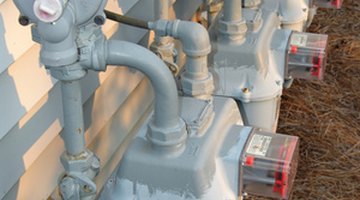How to Connect a Natural Gas Meter
Gas pipelines are made of sections of steel gas pipes, which are usually factory-threaded at both ends. Generally, the pipes are 3/4-inch thick in diameter.

Things You Will Need
- Wire brush
- Threading compound
- Small brush
- Pipe wrench
The sections of pipe (usually 8-foot lengths) are connected together with threading compound and steel couplings, which are available in 30, 45, 60, 90 and 180-degree angles. Connecting the gas pipe to the meter is the first step before installing the rest of the gas line in place, and is a quick process.
-
Clean one threaded end of the gas pipe, using a steel brush. Also make sure that there is no dirt in the inlet on the gas meter.
-
Apply threading compound all around the thread at one end of the piece of gas pipe, using a small brush. The gas meter will have a pipe coming from the meter that either has a tee coupling or a 90-degree elbow joint fitted to it. The tee coupling will have one inlet sealed with a steel plug, and one inlet open for the gas pipe.
-
Thread the compounded end of the piece of steel pipe into the tee coupling that is attached to the meter. Do this by hand.
-
Place the jaws of a pipe wrench around the new piece of gas pipe, close to the meter. Turn the wrench clockwise to tighten the pipe to the meter.
Tip
When the gas pipeline has been fully installed with gas shut-off valves placed at the ends of the line, the gas should be turned on. Apply soapy water to each and every pipe joint (coupling), as well as where the initial piece of pipe enters into the gas meter. If you see bubbles, the joints and pipe need to be tightened until no more bubbles are present. All gas pipelines should be checked with the permit office before they are used.
Writer Bio
Steve Sloane started working as a freelance writer in 2007. He has written articles for various websites, using more than a decade of DIY experience to cover mostly construction-related topics. He also writes movie reviews for Inland SoCal. Sloane holds a Bachelor of Arts in creative writing and film theory from the University of California, Riverside.
Photo Credits
- natural gas meter image by Tijara Images from Fotolia.com
- natural gas meter image by Tijara Images from Fotolia.com
More Articles



